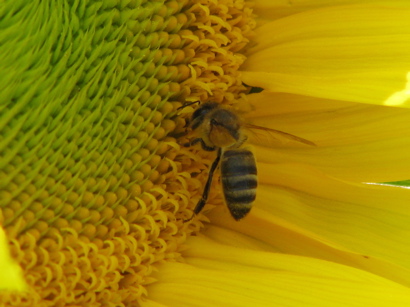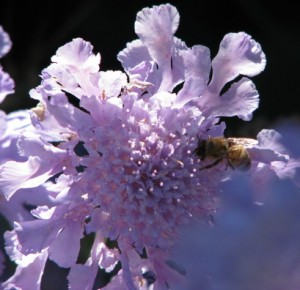Milkweed and Friends


There’s a monarch on our milkweed.
There’s a monarch on our milkweed!
You know how happy that makes me, right?
Here she is (not on the milkweed):

Welcome, little dear. Invite your friends!
Did you notice the bee had some company in that last photo? I didn’t, until I looked closely at the next one. Nasty little sapsucking beasties. And yet—they’re rather lovely, aren’t they, all rosy in the morning light?


(Poetry Friday visitors, Miss Dickinson awaits you at the bottom of the post.)
I mentioned I’ve become hooked on beekeeping blogs ever since reading Fruitless Fall. Here are a few of my favorites:
Hive Mind Bee Blog. A backyard beekeeper in Washington. I especially enjoyed his account of a swarm in his neighborhood:
When they’re flying in the air, there’s nothing you can do but watch, but when the queen lands, the rest of the swarm will land around her in a huge, sedate clump that you can put into a bucket or a box and put back into a hive. Julie made a quick call to Dawn of the Puget Sound Beekeeper’s Association, got some info on how to proceed, and we were back in business. I threw on some overalls and my bee shirt, grabbed a bucket and a spatula, and I’s ready for action. First, though, I stopped off at the school across the street where kids and parents were doing landscaping and upkeep on the grounds and let them know that we had a science fair moment, if they were interested. A couple of the moms gathered up a dozen or so 5 – 10 yr olds and they all trooped over to see the bees.
Honey Run Apiaries. Great pictures, thoughtful discussion, wry observations.
I recently read an 1858 book ‘Phelps Bee-Keeper’s Chart‘. The book is obviously horribly out of date and out of print (though it is available on-line). Though it is interesting none-the-less for several reasons. While it does cover a lot about honey bees, much of it is for the purpose of promoting the authors patented ‘Ohio Combination Bee-Hive‘ saying that he expects it to ‘ supersede all others’. Sadly, while it apparently claimed honors at the Ohio and other state fairs, his book was published 6 years after Lorenzo Lorraine Langstroth’s book ‘The Hive and the Honey Bee’, which details the bee hive most of us use today in the US and in other parts of the world.
Fruitless Fall discussed the rise of the Langstroth hive, so that was a neat connection for us. Amusing tidbit at the bottom of that post:
The running joke is that if you ask 5 beekeepers in a room a question, you will receive 6 different answers. Apparently this is one of the oldest beekeeping jokes on record. Phelps wrote nearly 150 year ago that ‘there is scarcely any subject on which such a diversity of opinion exists, as on the form and size of bee-hives, and the general management of bees.’
Linda’s Bees might be my favorite beekeeping blog so far. She writes from Atlanta and posts the most incredible pictures, really informative shots that let you see the action inside a hive. Her hives have fun names like Bermuda and Mellona (the Roman goddess of bees). Excellent sidebar full of links we’re exploring as time permits.
We rented this NOVA film about bees: Tales from the Hive. The cinematography was fairly stunning. The corresponding website has video of the different bee dances and an interview with the filmmaker about how he managed the breathtaking closeup shots of bees in flight.
The next step was to find out how I could fly with the bees, because they are fast. I told myself, if I can’t fly with the bee, then the bee has to fly with me—that is, with the camera, directly in front of the lens. It was like the work at a clockmaker’s. We used a pair of tiny tweezers to form a wafer-thin wire. We then tied the bee up with this—very carefully, because we did not want to harm the bee, and we wanted to make sure it had the freedom to move its wings. A special kind of arrangement enabled us to fix the wire to the camera.
The film was made in 2000, before the beginning of bee colony collapse and I think possibly even before the massive varroa infestation that has crippled so many hives in recent years.
My dear daddy sent me some cool links:
How to make a house for mason bees
Pursuit of the perfect pollinator
(Thanks, Dad!)
Since today is Poetry Friday, let me leave you with a little Emily Dickinson.
The Bee
Like trains of cars on tracks of plush
I hear the level bee:
A jar across the flowers goes,
Their velvet masonry
Withstands until the sweet assault
Their chivalry consumes,
While she, victorious, tilts away
To vanquish other blooms.
Her feet are shod with gauze,
Her helmet is of gold;
Her breast, a single onyx
With chrysoprase, inlaid.
Her labor is a chant,
Her idleness a tune;
Oh, for a bee’s experience
Of clovers and of noon!


As you know, I’ve had bees on my mind for weeks. I keep talking about Fruitless Fall: The Collapse of the Honey Bee and the Coming Agricultural Crisis, the book about bee colony collapse written by my former grad-school classmate, Rowan Jacobsen.
How much have you read about bee colony collapse?
I knew the honeybee’s numbers were declining. I remember hearing the wacky cell phone theory several years back, and that was laughed out of the news, and since then I’ve just heard ominous mutterings now and then about the bees disappearing and nobody knows why.
But I didn’t know the half of it.
I didn’t know, for example, that nowadays U.S. beekeepers earn most of their income—far more than they earn selling honey—trucking their hives around the country to pollinate crops. Somehow this gobsmacks me. We are dependent on migrant worker bees for the produce we grow in this country.
I definitely didn’t know that in the winter of 2006/2007, huge numbers of these hives began to die, and no one is sure exactly why. There are theories, which is a lot of what Rowan’s book is about: an in-depth and thoughtful exploration of what could possibly be causing the collapse of our bee colonies.
As I said above, when I heard about “the disappearance of the honeybee” I thought it meant declining numbers. Pesticides, I assumed (and indeed that seems to be a major factor). What I didn’t get was that bees literally disappeared. The hives died because the forager bees flew out and didn’t fly back home. There are diseases and pests that kill bees, and you find dead bees in and around the hive. (That’s happening too, in horrifying numbers.) But in other cases, the bees just up and disappeared. One possible explanation, Rowan learned, is a kind of disorientation and memory loss known to be a symptom of neurological damage caused by certain pesticides. It’s possible the bees are suffering from something like bee Alzheimer’s due to exposure to toxins meant to kill other insects. They fly off to work and can’t find their way back home. And in other hives, there are bees carrying every bee disease, fungus, and pest known to afflict the honeybee world—all at once. It’s as if their immune systems have been decimated (possible cause: the catastrophic wave of varroa mite infestation that arrived in this country a few years back and is a terrible scourge in many parts of the world right now), leaving them susceptible to other illnesses.
And it isn’t just the honeybees: we know a lot about the decline in their numbers because they are domesticated bees, owned by devoted beekeepers who know exactly how many hives they have lost to varroa and bee colony collapse. No one has good numbers on all the other pollinating insects out there, except it seems clear honeybees aren’t the only pollinators in decline. Did you know vanilla beans are hand-pollinated by humans? The insect pollinator has been wiped out.
 Obviously Fruitless Fall made a big impact on me. Shook me up; Jane too. The funny thing is, at the very same time that it was scaring the pants off me (a world short on pollinators is a scary, scary concept), it was filling me with wonder and delight. I know that sounds impossible. It’s the way Rowan looks so closely, with humor, warmth, and affection, at this ordinary (extraordinary!) creature, the honeybee. It reminded me of the John Stilgoe book I kept raving about last year, Outside Lies Magic. Remember that one? What Stilgoe did for me with power lines and telephone poles, Rowan Jacobsen did for me with bees and honey and even figs. The early chapters describing life in a beehive and the life cycle of the bee were so engaging that I read them aloud to 8-year-old Beanie, who was captivated. Jane (almost 14) has read the book at least three times now. She begged me to order Rowan’s book on chocolate—along with our very own copy of Fruitless Fall. Which is a good thing, because I find myself wanting to thrust the book at everyone I talk to. It’s that kind of book.
Obviously Fruitless Fall made a big impact on me. Shook me up; Jane too. The funny thing is, at the very same time that it was scaring the pants off me (a world short on pollinators is a scary, scary concept), it was filling me with wonder and delight. I know that sounds impossible. It’s the way Rowan looks so closely, with humor, warmth, and affection, at this ordinary (extraordinary!) creature, the honeybee. It reminded me of the John Stilgoe book I kept raving about last year, Outside Lies Magic. Remember that one? What Stilgoe did for me with power lines and telephone poles, Rowan Jacobsen did for me with bees and honey and even figs. The early chapters describing life in a beehive and the life cycle of the bee were so engaging that I read them aloud to 8-year-old Beanie, who was captivated. Jane (almost 14) has read the book at least three times now. She begged me to order Rowan’s book on chocolate—along with our very own copy of Fruitless Fall. Which is a good thing, because I find myself wanting to thrust the book at everyone I talk to. It’s that kind of book.


